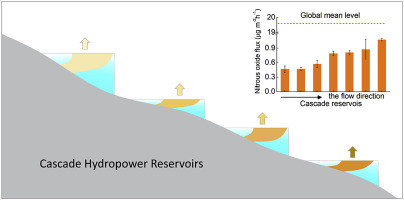当前位置:
X-MOL 学术
›
Water Res.
›
论文详情
Our official English website, www.x-mol.net, welcomes your
feedback! (Note: you will need to create a separate account there.)
Nitrous oxide emissions from cascade hydropower reservoirs in the upper Mekong River.
Water Research ( IF 11.4 ) Pub Date : 2020-02-03 , DOI: 10.1016/j.watres.2020.115582 Wenqing Shi 1 , Qiuwen Chen 1 , Jianyun Zhang 2 , Dongsheng Liu 3 , Qitao Yi 4 , Yuchen Chen 3 , Honghai Ma 3 , Liuming Hu 3
Water Research ( IF 11.4 ) Pub Date : 2020-02-03 , DOI: 10.1016/j.watres.2020.115582 Wenqing Shi 1 , Qiuwen Chen 1 , Jianyun Zhang 2 , Dongsheng Liu 3 , Qitao Yi 4 , Yuchen Chen 3 , Honghai Ma 3 , Liuming Hu 3
Affiliation

|
Nitrous oxide is a powerful greenhouse gas, and its emissions from single reservoirs have been extensively studied; however, it still remains unclear about nitrous oxide emission patterns in cascade reservoirs. In this study, nitrous oxide emissions from cascade hydropower reservoirs were investigated using the thin boundary layer model in the heavily dammed upper Mekong River. Meanwhile, sediment denitrification for nitrous oxide production was analysed using the stable isotope method and the quantitative polymerase chain reaction method. Our results demonstrated that nitrous oxide emissions (0.47-1.08 μg m-2h-1) in the upper Mekong River were much lower than the global mean level (19.60 μg m-2h-1), but were increased by dam constructions; nitrous oxide emissions exhibited an increase trend along the flow direction in the cascade reservoirs. Sediment accumulation by dams supplied sufficient nitrogen substrates and organic carbon, creating hotspots of denitrification at the transition zone in reservoirs. As the elevation decreased, the increase in temperature enhanced microbial denitrification at the active zone, and thereby increased nitrous oxide production with the prolonged residence time. This study advanced our knowledge on nitrous oxide emissions from cascade hydropower systems.
中文翻译:

湄公河上游梯级水库的一氧化二氮排放量。
一氧化二氮是一种强大的温室气体,人们已经对其单一储层的排放进行了广泛的研究。然而,对于梯级油藏中的一氧化二氮排放模式仍不清楚。在这项研究中,使用薄边界层模型对重坝湄公河上游的梯级水库水体中的一氧化二氮排放进行了研究。同时,采用稳定同位素法和定量聚合酶链反应法对沉积物反硝化生产一氧化二氮进行了分析。我们的结果表明,湄公河上游的一氧化二氮排放量(0.47-1.08μgm-2h-1)远低于全球平均水平(19.60μgm-2h-1),但由于大坝建设而增加;梯级油藏中的一氧化二氮排放量沿流动方向呈增加趋势。大坝沉积物的积聚提供了充足的氮底物和有机碳,从而在储层过渡带形成了反硝化的热点。随着海拔的降低,温度的升高会增强活性区的微生物反硝化作用,从而随着停留时间的延长而增加一氧化二氮的产生。这项研究提高了我们对梯级水电系统一氧化二氮排放的认识。
更新日期:2020-02-03
中文翻译:

湄公河上游梯级水库的一氧化二氮排放量。
一氧化二氮是一种强大的温室气体,人们已经对其单一储层的排放进行了广泛的研究。然而,对于梯级油藏中的一氧化二氮排放模式仍不清楚。在这项研究中,使用薄边界层模型对重坝湄公河上游的梯级水库水体中的一氧化二氮排放进行了研究。同时,采用稳定同位素法和定量聚合酶链反应法对沉积物反硝化生产一氧化二氮进行了分析。我们的结果表明,湄公河上游的一氧化二氮排放量(0.47-1.08μgm-2h-1)远低于全球平均水平(19.60μgm-2h-1),但由于大坝建设而增加;梯级油藏中的一氧化二氮排放量沿流动方向呈增加趋势。大坝沉积物的积聚提供了充足的氮底物和有机碳,从而在储层过渡带形成了反硝化的热点。随着海拔的降低,温度的升高会增强活性区的微生物反硝化作用,从而随着停留时间的延长而增加一氧化二氮的产生。这项研究提高了我们对梯级水电系统一氧化二氮排放的认识。











































 京公网安备 11010802027423号
京公网安备 11010802027423号